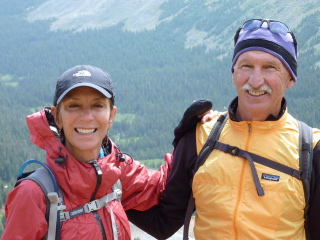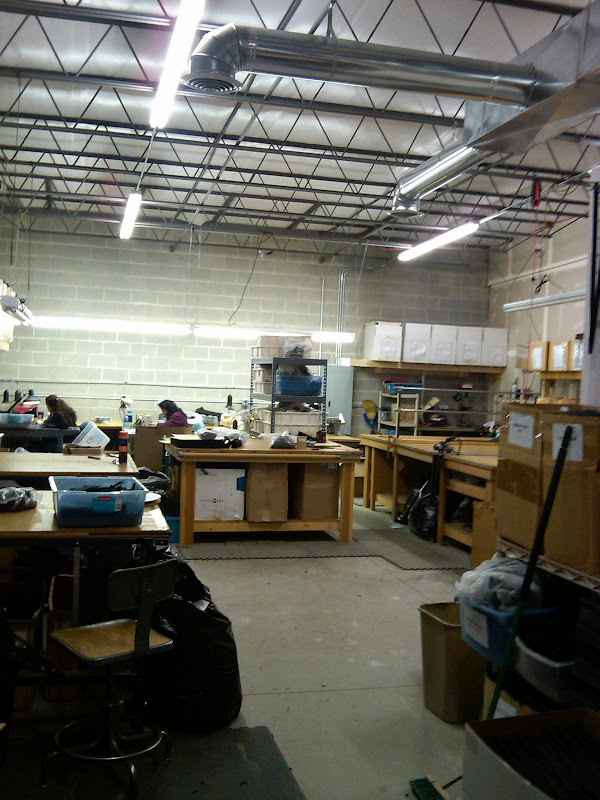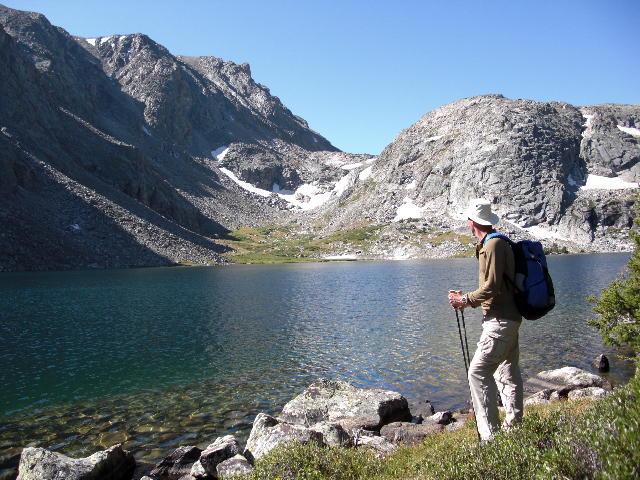At the beginning of the week I saw, with some surprise, that ULA had changed owners. So the maker of my beloved Ohm had changed owners like that over the late autumn - no surprise I didn't get an answer from Brian Frankle upon my interview request. Chris McMaster, together with his wife Sally, took over the helm at ULA Equipment and I was able to get in touch with Chris to answer my questions.

Chris and Sally on the Pawnee pass, Colorado, this summer - 2 minutes before a blinding hail/ lightning storm sent them running off the top.
Chris, since when are you backpacking, and how did you start? How often are you out backpacking nowadays?
I began backpacking as a student at Colorado State University, I had always loved the outdoors, and exploring the backcountry was a natural extension of that interest. We usually get out for one good trip a year, but I have many outdoor passions, including cross county skiing, mountain and road biking, and fly fishing. For instance last Saturday I hiked up to 8500 feet with my skis, skied for a while, came down a bit and hunted grouse on the lower aspen covered benches, caught a few trout in the logan river, and then went for a 2 hour mountain bike ride.
When and why did you start to go lightweight/ UL?
I really wouldn't call myself an ultralight backpacker, as most of my trips involve some other sport, usually fishing, and I schlep along quite a bit of extra gear. Sally is an amazing artist, and again most of our trips also involve carrying a small easel, seat and paints. Check out her website sallycastleman.com.
ULA Equipment is by many considered one of the best backpack manufacturers when it comes to smart design, usability on the trail, durability while still being lightweight. Brian, and with him Casey and the sewers, were the backbone of ULA, so many of us are now wondering how ULA will continue. Can you give us all a little insight what you and your wife Sally have planned with ULA? Also, are you going to be sewing yourself, or will you be responsibly solely for the business side?
We have retained all of the employees, including and especially Casey, as he is the one who is truly a part of the UL community, and other than Brian not being there every day at some point in the future, nothing has changed. I'm trying to learn everything that happens in the back, but the sewers are so skilled that I can't imagine ever spending much time behind a machine, and I'm not so sure that me sewing would do much to further our reputation for quality.

The new ULA workshop - more space, same people who produce awesome packs.
Will Brian be still be involved in ULA, maybe in a similar role as Glen Van Peski at Gossamer Gear, or will he be gone and pursue his own adventures?
I can't speak for Brian, I know he's ready for some much deserved time off, and we'll see after that.
How will the R&D now work at ULA? I read you were testing a new alpine style backpack, which you and Brian both were thinking off independently, and which you were testing already. Will Brian be part of R&D?
The Alpine pack is total speculation on the part of a blogger on another website, and it is not the next product we will unveil, however for the time being there are several Brian designs that we have that have not been brought to market, and Casey and I have a few ideas of our own, but I wouldn't look for a flood of new stuff in the near future.
Even if you just bought the business, do you know what is the most sold piece of equipment from ULA Equipment?
The Catalyst is our biggest seller.
How easy, or difficult, do you expect it to be to compete versus the mass market manufacturers which come out with always lighter backpacks?
When I look at our products, and the products of our fellow cottage industry manufactuers I am amazed that we use much more expensive materials, our labor costs are 5 times the big guys, yet we produce a better product for the same price as their inferior ones. While certainly lighter is always going to be a big selling point, we are more concerned with producing a pack that does it's job for a very long time.
What kind of new innovations can we expect in the next years from ULA Equipment, besides the mentioned alpine backpack?
Again, the alpine pack does not exist, but look for us to branch out into equipment for other endurance sports.

Chris climbing in Boulder Canyon, Colorado.
What is your own favorite backpack, sleeping system and shelter, and did you make it yourself?
Other than my Catalyst my equipment would make most light weight folks cringe, and I have never sewn anything larger than a button.
What was your last longer backpacking trip, and what was your baseweight? Are you trying to get lighter and lighter still, or did you already reach your perfect setup?
My last long trip was into the flattop wilderness in Colorado, my base weight was about 20 as I carry the tent, cook gear, ect. not to mention my flyfishing gear.
Do you think ultralight backpacking will become more popular and break into the mass market, or will it continue to be something for a small group of people?
I don't think you can find a sport where the trend isn't towards lighter and stronger, so from the standpoint of equipment I think that trend will continue, but I am very concerned that people, particularly on the coasts, are so unconnected to the outdoors, people are so filled with fear about everything that it's not uncommon for an 18 year old boy to have never been alone in the woods, so I'm not sure where the next generation of backpackers is going to come from.
We heard from Glen Van Peski that there is "Brain Trust" hike every year in which the cottage manufacturers hike together for a week. Will you be there with them in the future?
If I'm invited I'll be there!
Chris, I thank you for taking the time to answer my questions. I wish you and your wife Sally, as well as Casey and the sewers, all the best and am looking forward towards the developments at ULA Equipment!
And here the interview stops. It thus seems that Chris and Sally will work together with Brian, Casey and the sewers and we do not need to be afraid of radical changes to ULA Equipment in the future - no need to buy now multiple copies of your favourite backpack and hoard them! I'm feeling good about this news, being an entrepreneur myself, and having grown up in an entrepreneur family, I understand that it can be difficult to keep that spark going over long periods and that therefore some fresh blood can be a good thing.


Chris and Sally on the Pawnee pass, Colorado, this summer - 2 minutes before a blinding hail/ lightning storm sent them running off the top.
Chris, since when are you backpacking, and how did you start? How often are you out backpacking nowadays?
I began backpacking as a student at Colorado State University, I had always loved the outdoors, and exploring the backcountry was a natural extension of that interest. We usually get out for one good trip a year, but I have many outdoor passions, including cross county skiing, mountain and road biking, and fly fishing. For instance last Saturday I hiked up to 8500 feet with my skis, skied for a while, came down a bit and hunted grouse on the lower aspen covered benches, caught a few trout in the logan river, and then went for a 2 hour mountain bike ride.
When and why did you start to go lightweight/ UL?
I really wouldn't call myself an ultralight backpacker, as most of my trips involve some other sport, usually fishing, and I schlep along quite a bit of extra gear. Sally is an amazing artist, and again most of our trips also involve carrying a small easel, seat and paints. Check out her website sallycastleman.com.
ULA Equipment is by many considered one of the best backpack manufacturers when it comes to smart design, usability on the trail, durability while still being lightweight. Brian, and with him Casey and the sewers, were the backbone of ULA, so many of us are now wondering how ULA will continue. Can you give us all a little insight what you and your wife Sally have planned with ULA? Also, are you going to be sewing yourself, or will you be responsibly solely for the business side?
We have retained all of the employees, including and especially Casey, as he is the one who is truly a part of the UL community, and other than Brian not being there every day at some point in the future, nothing has changed. I'm trying to learn everything that happens in the back, but the sewers are so skilled that I can't imagine ever spending much time behind a machine, and I'm not so sure that me sewing would do much to further our reputation for quality.

The new ULA workshop - more space, same people who produce awesome packs.
Will Brian be still be involved in ULA, maybe in a similar role as Glen Van Peski at Gossamer Gear, or will he be gone and pursue his own adventures?
I can't speak for Brian, I know he's ready for some much deserved time off, and we'll see after that.
How will the R&D now work at ULA? I read you were testing a new alpine style backpack, which you and Brian both were thinking off independently, and which you were testing already. Will Brian be part of R&D?
The Alpine pack is total speculation on the part of a blogger on another website, and it is not the next product we will unveil, however for the time being there are several Brian designs that we have that have not been brought to market, and Casey and I have a few ideas of our own, but I wouldn't look for a flood of new stuff in the near future.
Even if you just bought the business, do you know what is the most sold piece of equipment from ULA Equipment?
The Catalyst is our biggest seller.
How easy, or difficult, do you expect it to be to compete versus the mass market manufacturers which come out with always lighter backpacks?
When I look at our products, and the products of our fellow cottage industry manufactuers I am amazed that we use much more expensive materials, our labor costs are 5 times the big guys, yet we produce a better product for the same price as their inferior ones. While certainly lighter is always going to be a big selling point, we are more concerned with producing a pack that does it's job for a very long time.
What kind of new innovations can we expect in the next years from ULA Equipment, besides the mentioned alpine backpack?
Again, the alpine pack does not exist, but look for us to branch out into equipment for other endurance sports.
Chris climbing in Boulder Canyon, Colorado.
What is your own favorite backpack, sleeping system and shelter, and did you make it yourself?
Other than my Catalyst my equipment would make most light weight folks cringe, and I have never sewn anything larger than a button.
What was your last longer backpacking trip, and what was your baseweight? Are you trying to get lighter and lighter still, or did you already reach your perfect setup?
My last long trip was into the flattop wilderness in Colorado, my base weight was about 20 as I carry the tent, cook gear, ect. not to mention my flyfishing gear.
Do you think ultralight backpacking will become more popular and break into the mass market, or will it continue to be something for a small group of people?
I don't think you can find a sport where the trend isn't towards lighter and stronger, so from the standpoint of equipment I think that trend will continue, but I am very concerned that people, particularly on the coasts, are so unconnected to the outdoors, people are so filled with fear about everything that it's not uncommon for an 18 year old boy to have never been alone in the woods, so I'm not sure where the next generation of backpackers is going to come from.
We heard from Glen Van Peski that there is "Brain Trust" hike every year in which the cottage manufacturers hike together for a week. Will you be there with them in the future?
If I'm invited I'll be there!
Chris, I thank you for taking the time to answer my questions. I wish you and your wife Sally, as well as Casey and the sewers, all the best and am looking forward towards the developments at ULA Equipment!
And here the interview stops. It thus seems that Chris and Sally will work together with Brian, Casey and the sewers and we do not need to be afraid of radical changes to ULA Equipment in the future - no need to buy now multiple copies of your favourite backpack and hoard them! I'm feeling good about this news, being an entrepreneur myself, and having grown up in an entrepreneur family, I understand that it can be difficult to keep that spark going over long periods and that therefore some fresh blood can be a good thing.


